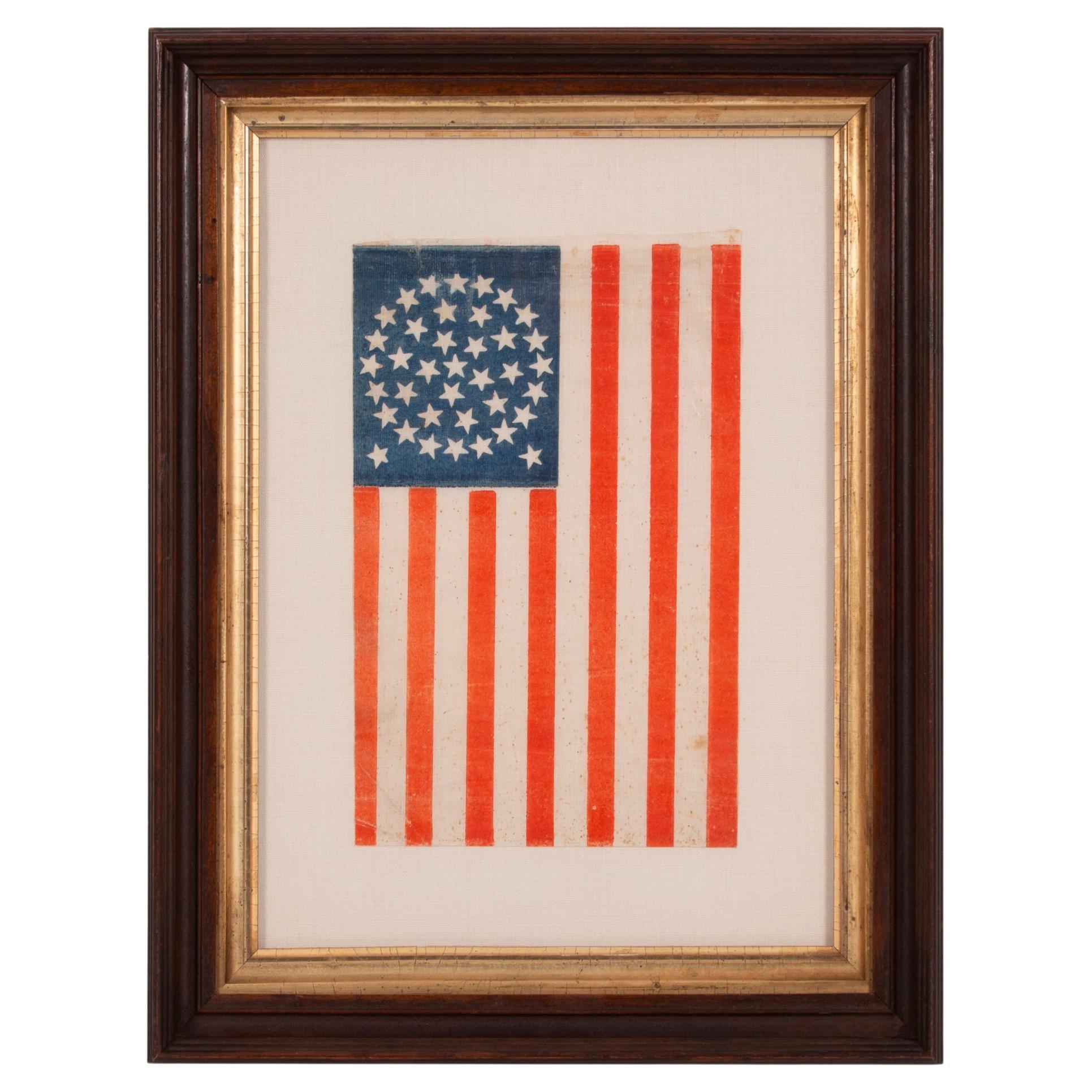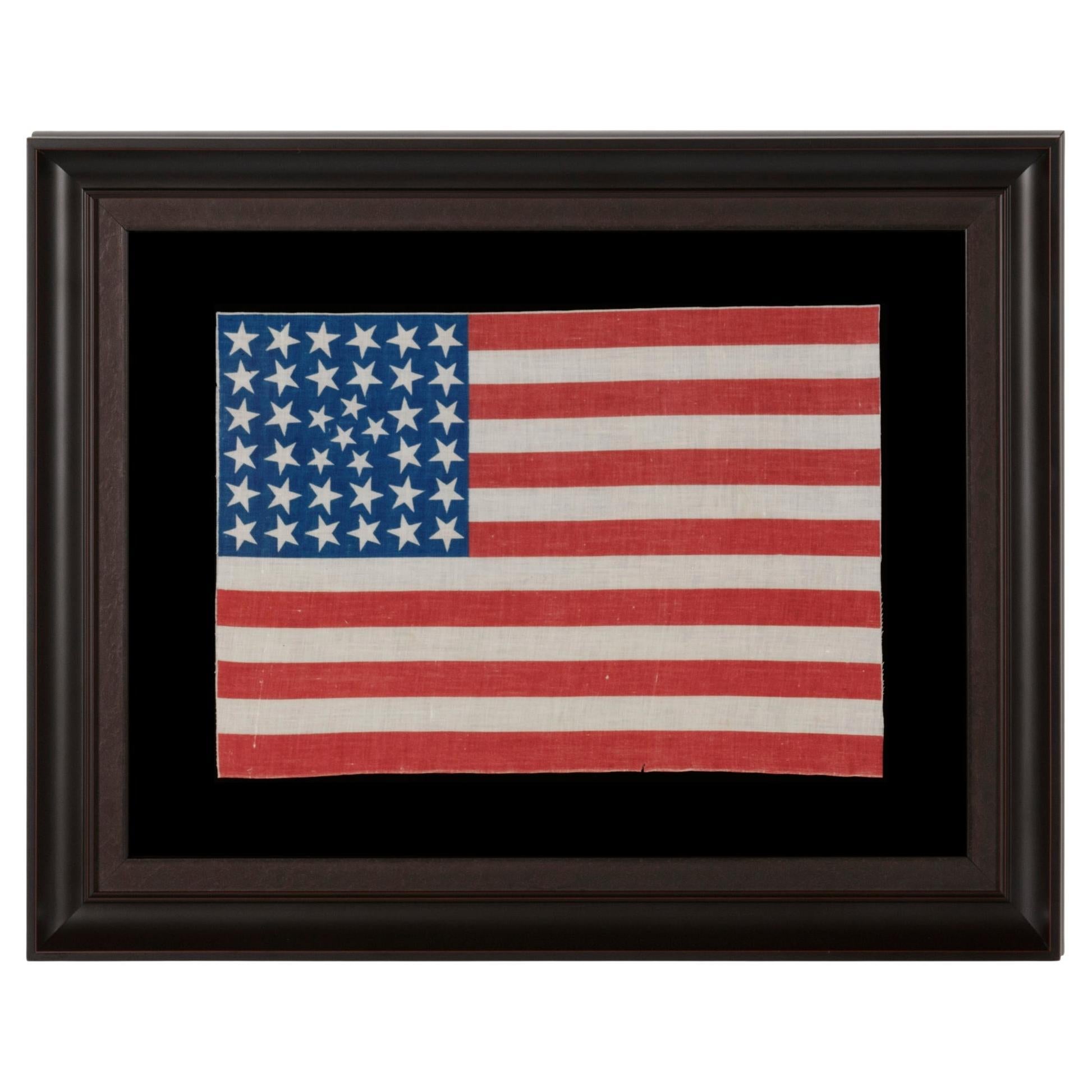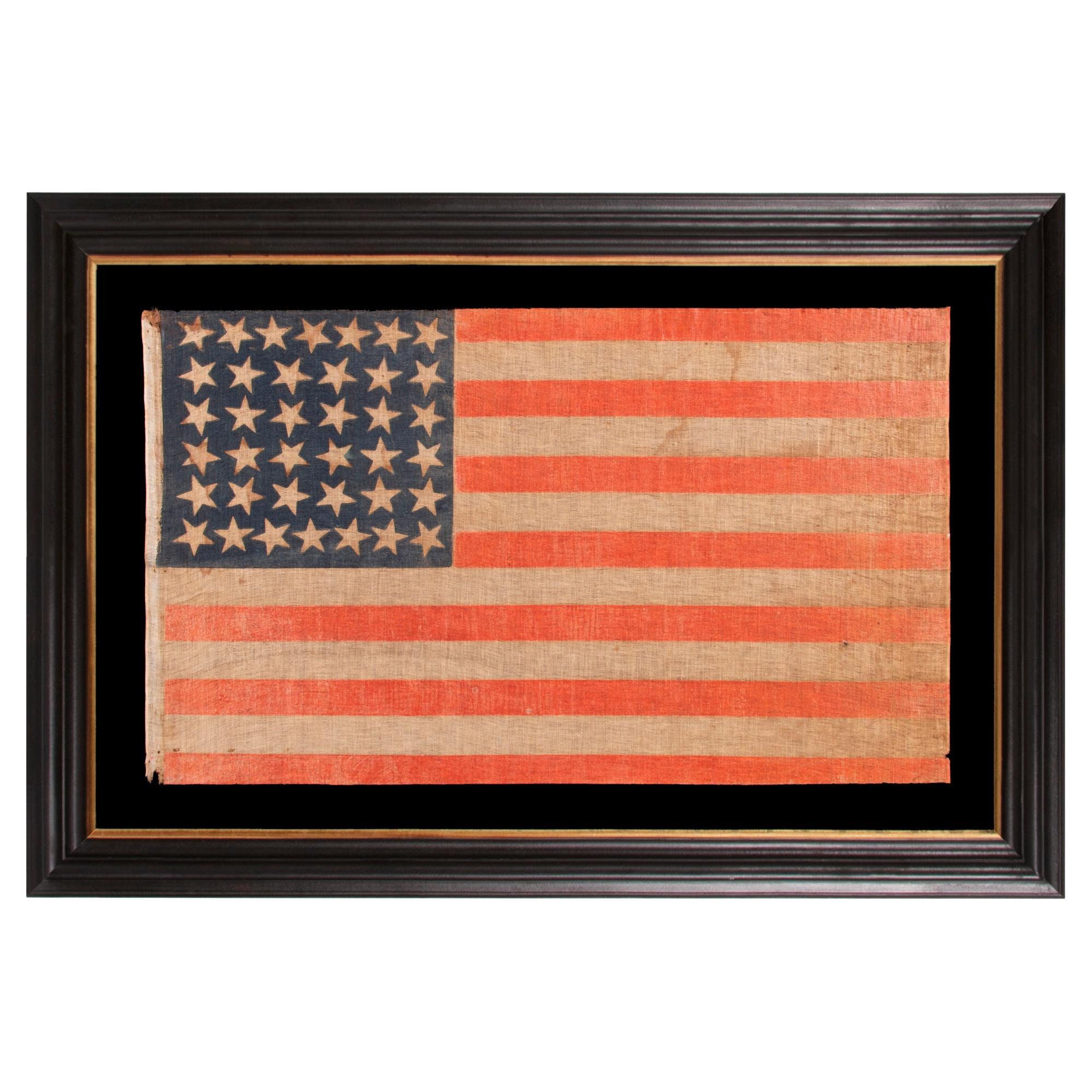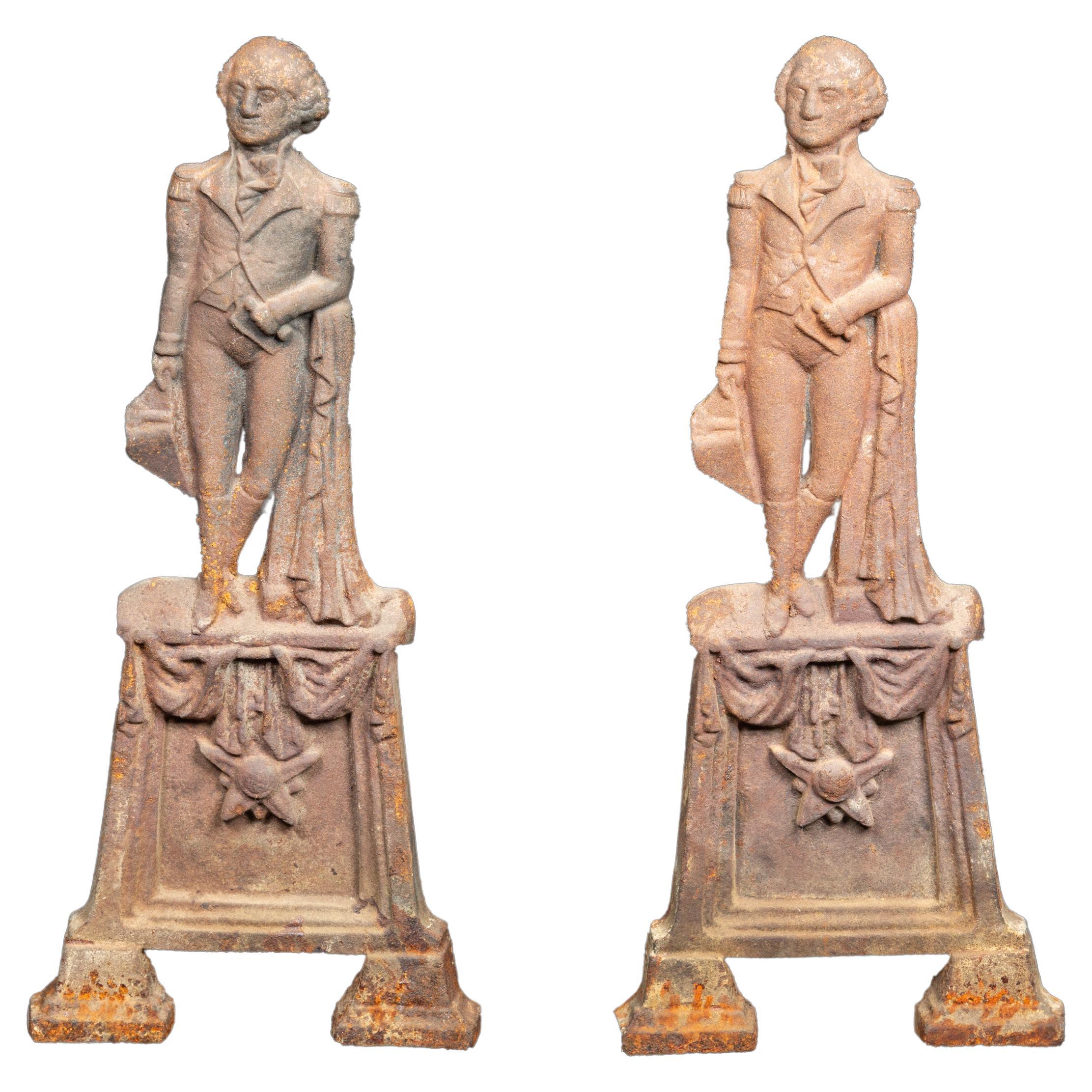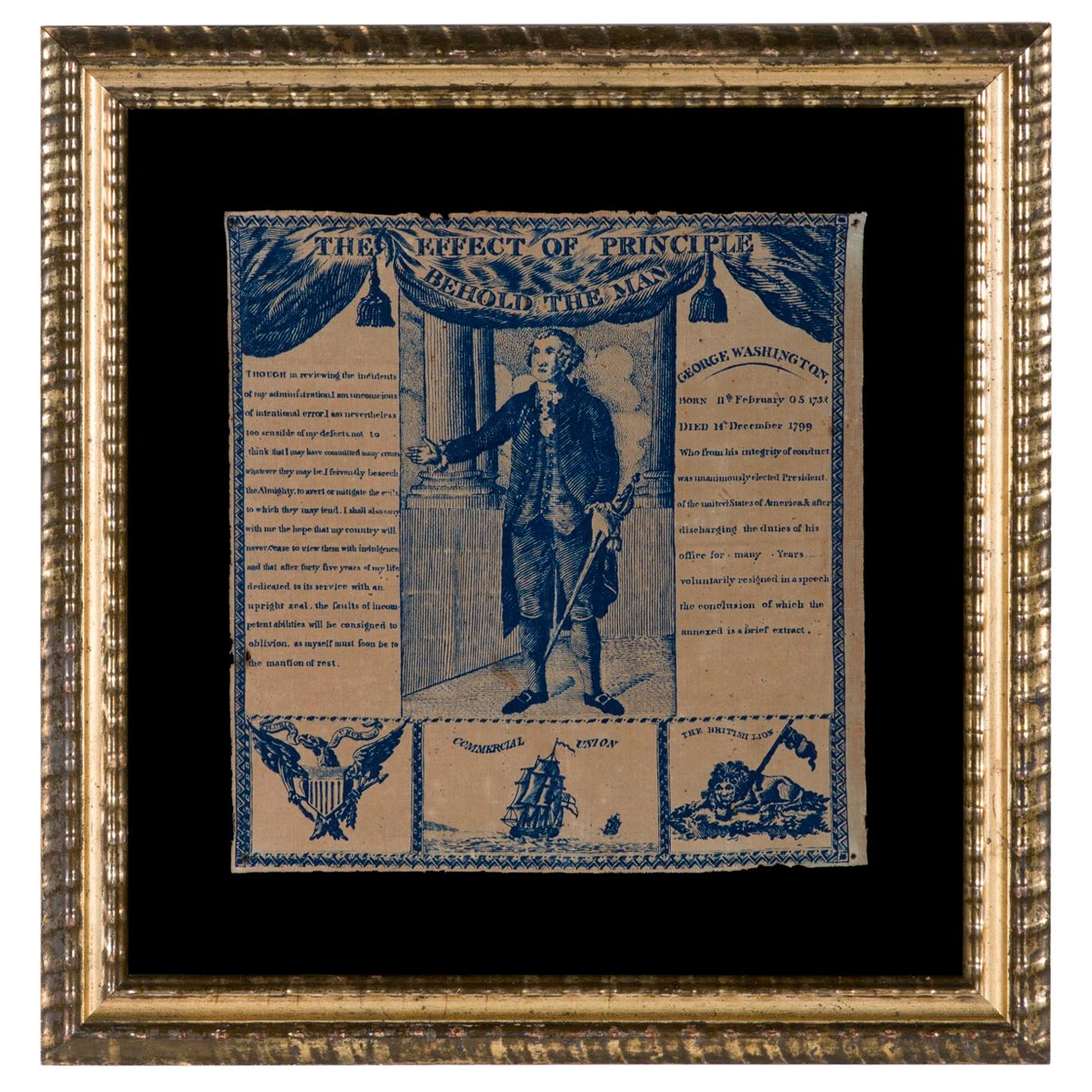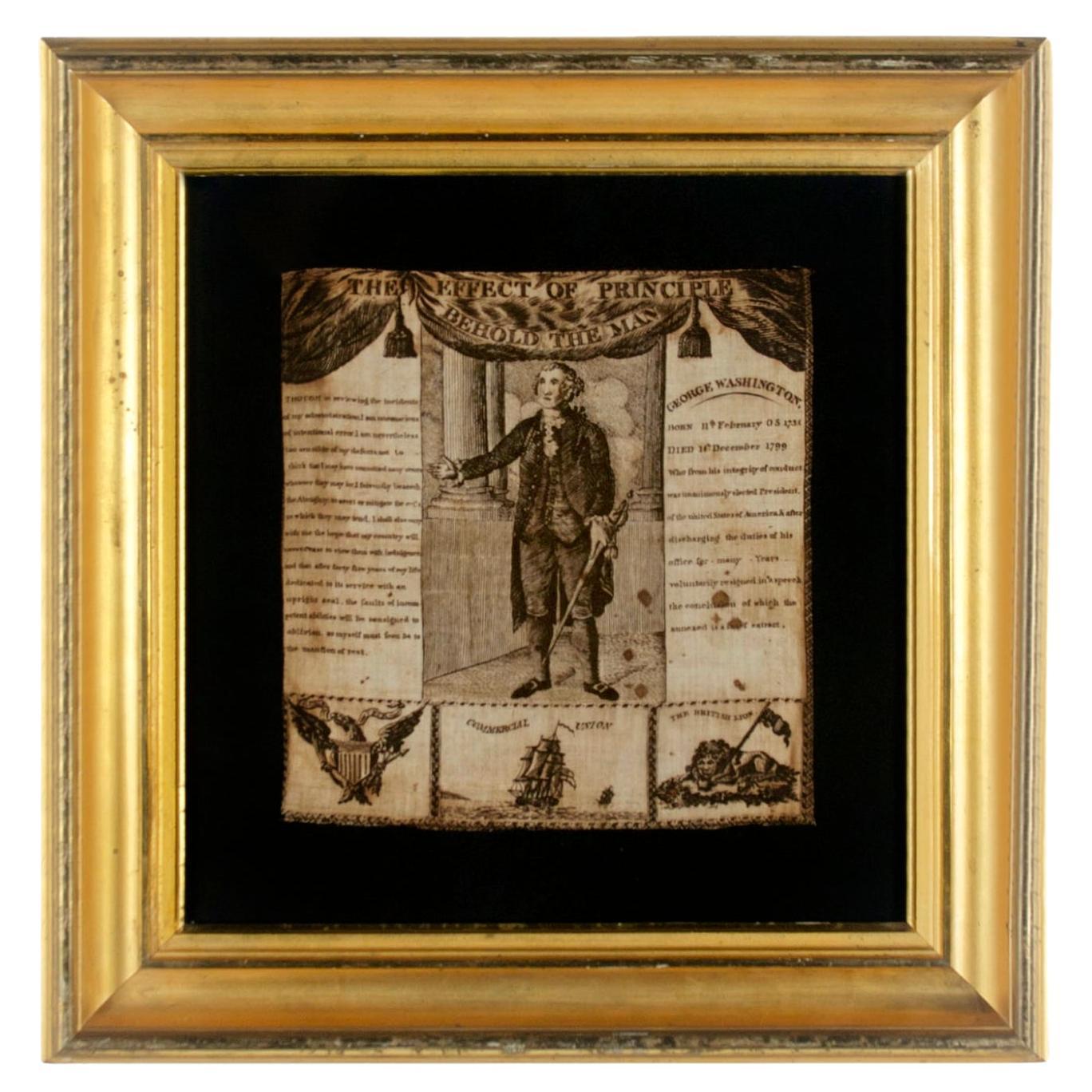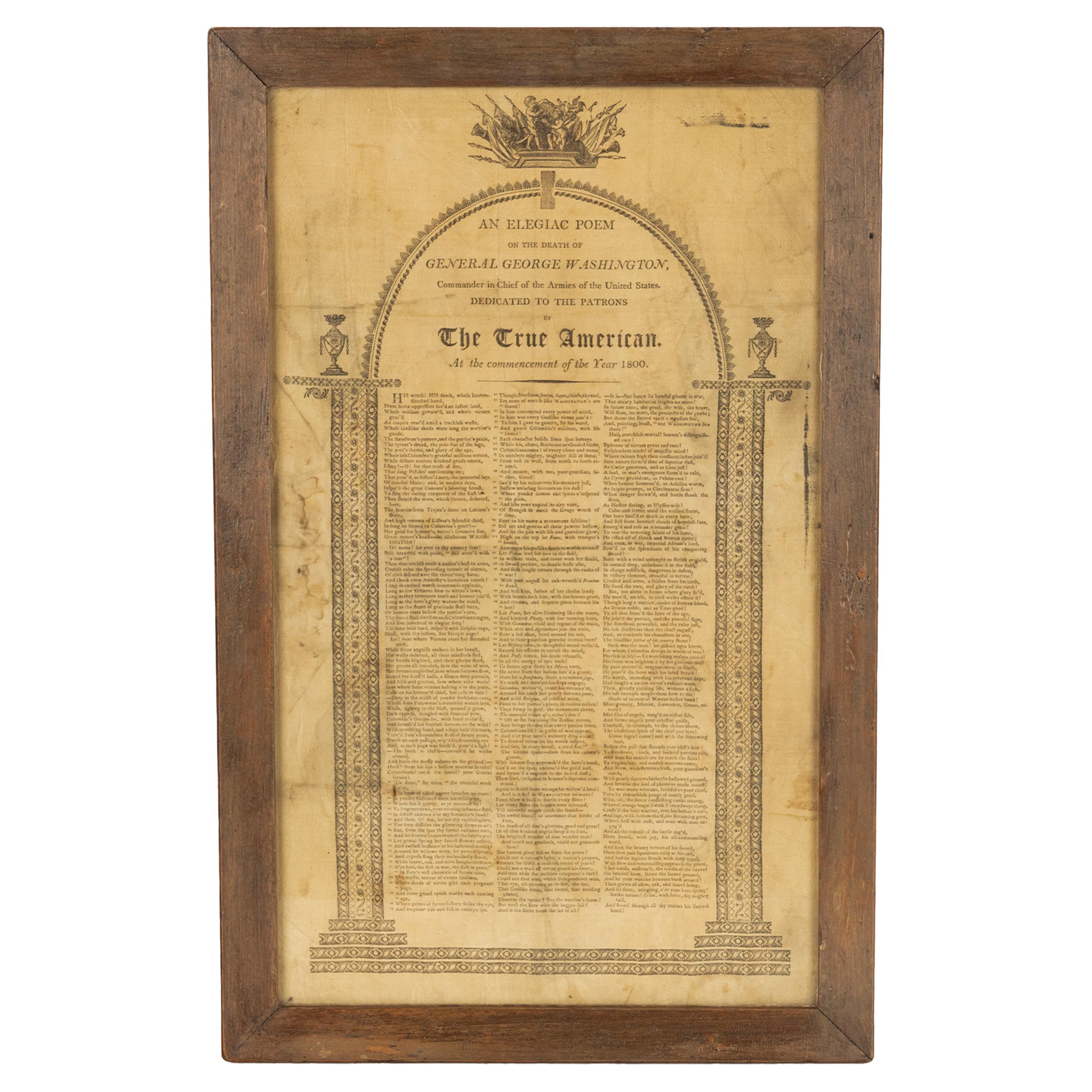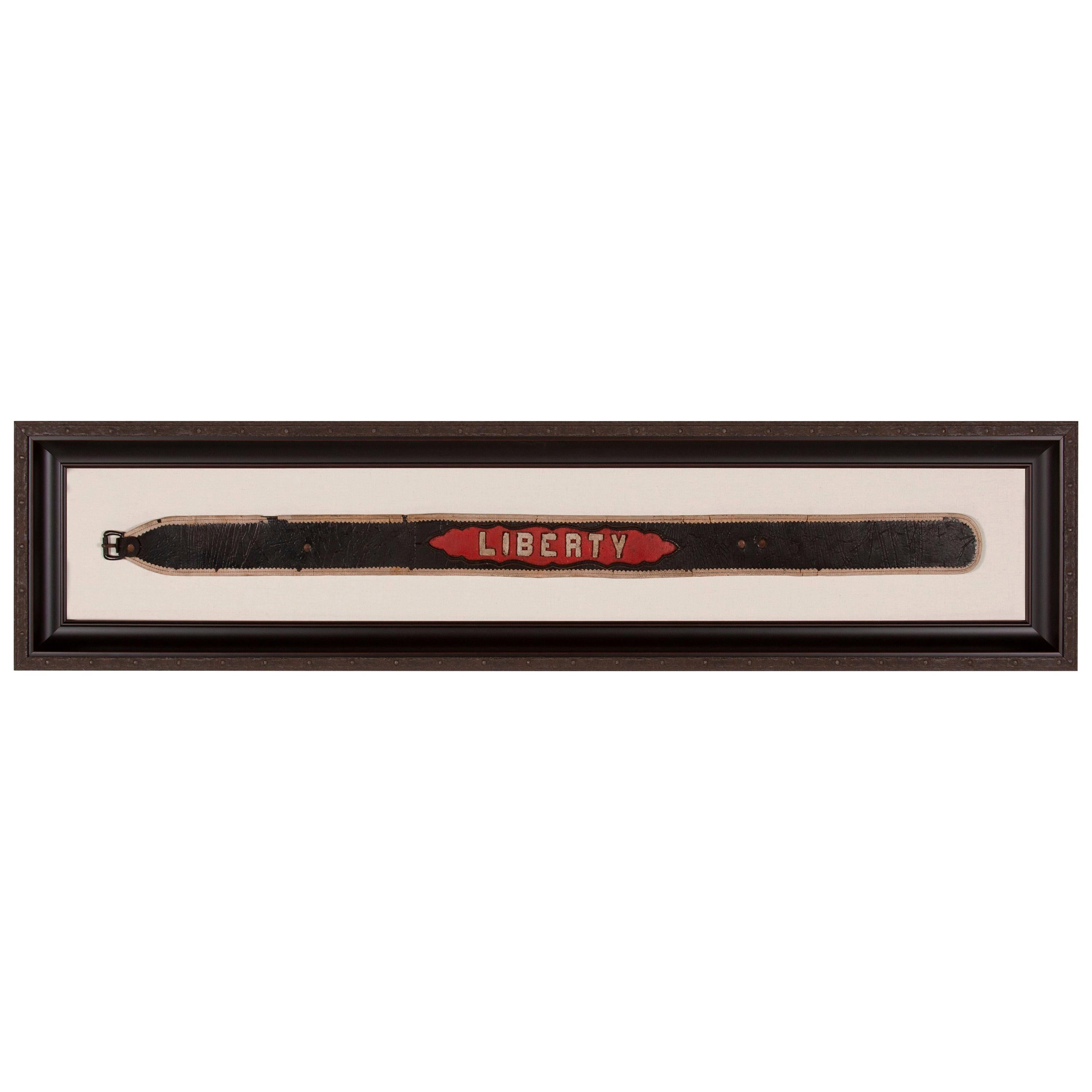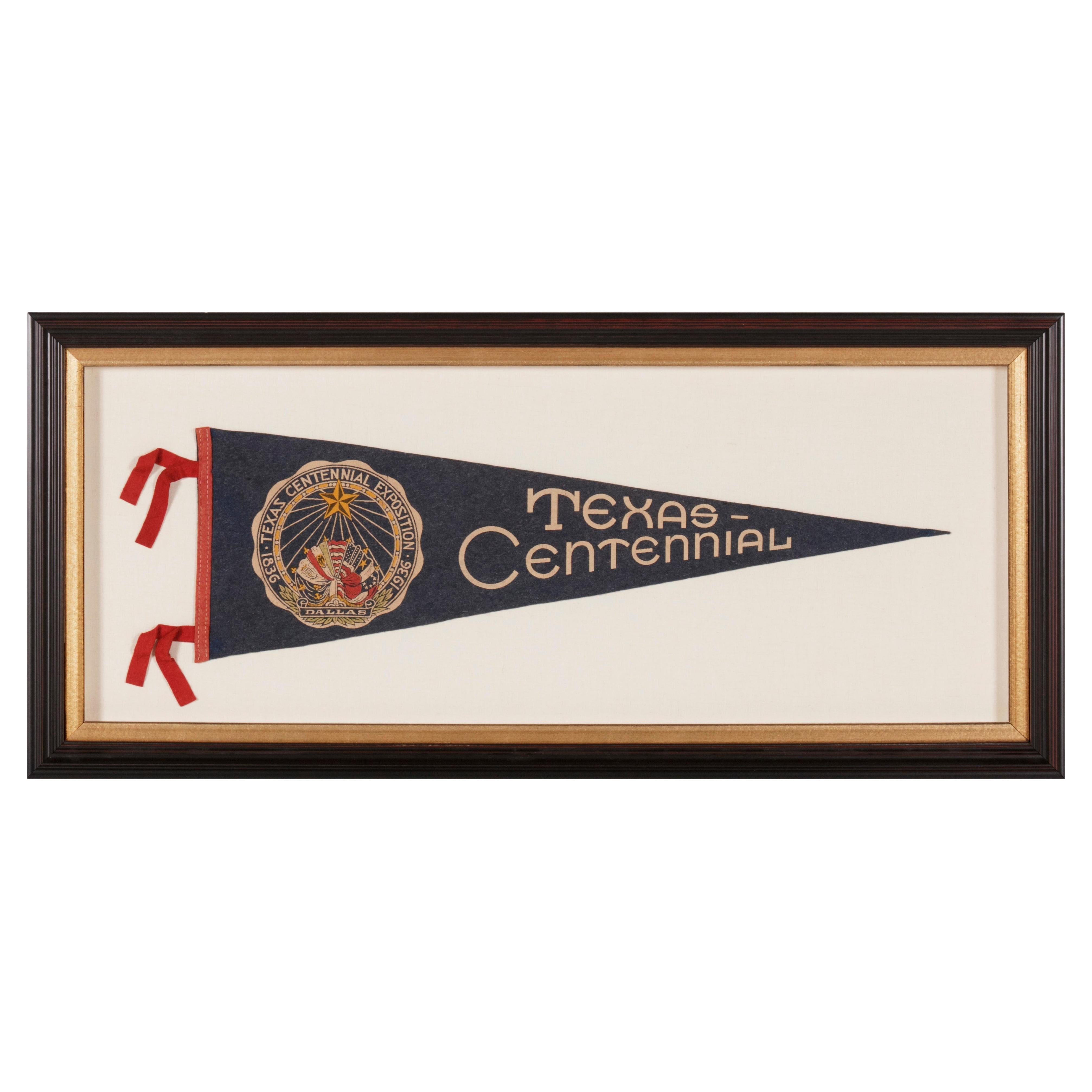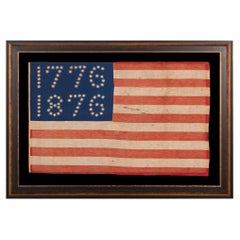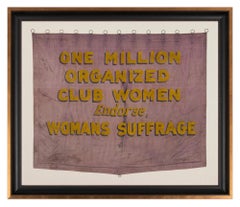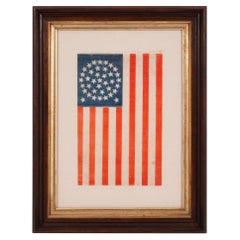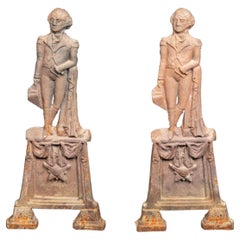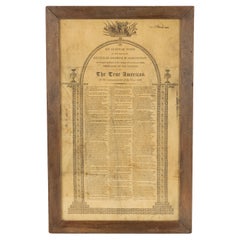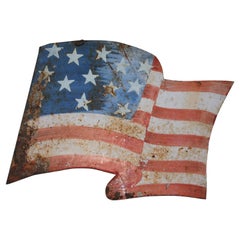
1876 Centennial Celebration Parade Banner With George Washington
View Similar Items
Want more images or videos?
Request additional images or videos from the seller
1 of 7
1876 Centennial Celebration Parade Banner With George Washington
About the Item
- Place of Origin:
- Period:
- Date of Manufacture:1876
- Condition:See Item Description.
- Seller Location:York County, PA
- Reference Number:Seller: pat-2221stDibs: U1204308497563
About the Seller
5.0
Recognized Seller
These prestigious sellers are industry leaders and represent the highest echelon for item quality and design.
Established in 1991
1stDibs seller since 2008
61 sales on 1stDibs
Typical response time: 10 hours
More From This SellerView All
- 1776-1876 Centennial Celebration Flag, ca 1876Located in York County, PAAntique American Flag with 10-pointed stars that spell “1776 – 1876”, Made for the 100-Year Anniversary Of American Independence,one of the most graphic of all early examples. Man...Category
Antique 1870s American Political and Patriotic Memorabilia
MaterialsCotton
Price Upon Request - Violet & Yellow Suffragette Parade Banner, Ca 1910-1920Located in York County, PARare violet & yellow Suffragette parade banner, the plate example illustrated in the text reference on the subject, made ca 1910-1920. Hand-painted banners...Category
Early 20th Century Political and Patriotic Memorabilia
MaterialsSilk
Price Upon Request - 38 Star Parade Flag with Stars in a Medallion Configuration, ca 1876-1889Located in York County, PA38 STARS IN A MEDALLION CONFIGURATION WITH 2 OUTLIERS, ON AN ANTIQUE AMERICAN FLAG WITH VIBRANT COLORATION, REFLECTS COLORADO STATEHOOD, 1876-1889, ILLUSTRATED IN “THE STARS & STRIPES: FABRIC OF THE AMERICAN SPIRIT” by RICHARD PIERCE, 2005 38 star American parade flag, printed on coarse, glazed cotton. The stars are arranged in a triple-wreath form of the medallion configuration, with a single center star and two stars flanking outside the basic pattern, toward the fly end. Most circular medallion patterns of this sort exhibit four flanking stars beyond the consecutive wreaths, one in each corner. The inclusion of only two was intentional, allowing for the easy addition of two more stars. Flag-makers knew that more Western Territories were soon to be added and eagerly anticipated their arrival. Use of fewer than four outliers was popular in 38 star parade flags, but is rarely encountered in other star counts. Note how the vibrant, chromatic luster of the orange stripes provides striking contrast with the blue canton, and how this contributes to the flag's beautiful presentation. Many parade flags in this star count have red stripes that lean heavily toward orange. This was common across printed flags produced between the 1850's and the 38 star period, phasing out in the last decade of the 19th century. Colorado became the 38th state on August 1st, 1876. This was the year of our nation’s 100-year anniversary of independence. Per the Third Flag Act of 1818, stars were not officially added until the 4th of July following a state's addition. For this reason, 37 was the official star count for the American flag in 1876. Flag-making was a competitive venture, however, and few flag-makers would have been continuing to produce 37 star flags when their competitors were making 38’s. It is for this reason that 38 and 13 stars (to represent the original 13 colonies) are more often seen at the Centennial International Exposition, the six-month long World’s Fair held in Philadelphia in honor of the event. Some flag-makers would have been adding a star for the 38th state even before it entered the Union, in the early part of 1876 or even prior. In fact, many makers of parade flags were actually producing 39 star flags, in hopeful anticipation of the addition of two more Western Territories instead of one. But the 39th state would not join the Union for another 13 years, when the Dakota Territory entered as two states on the same day. The 38 star flag generally fell from use at that time, though it technically remained official until July 3rd, 1890. President Ulysses S. Grant was in office when the first 38 star flags would have appeared. The list of presidents serving during the period when the 38 star flag was actually official, include Rutherford B. Hayes, James Garfield...Category
Antique Late 19th Century American Political and Patriotic Memorabilia
MaterialsCotton
Price Upon Request - 38 Star Antique American Parade Flag, Colorado Statehood, ca 1876-1889Located in York County, PA38 STARS IN AN EXTREMELY UNUSUAL CONFIGURATION THAT BEARS A CLUSTER OF 6 SMALL STARS WITHIN A LINEAL PATTERN OF LARGER STARS, 1876-1889, COLORADO STATEHOOD 38 star American national parade flag, printed on cotton. This is an extremely rare example of a lineal pattern flag with a wreath or cluster of smaller stars inserted in the center. A very small number of flags in this style are known to have survived, the colors of which are typically saturated and vibrant, like this example, in scarlet red and rich, royal blue. The particular wreath in the center of the configuration is really more of a pentagon with a single, center star. The reason for the choice of the design and 6 smaller stars seems a curious one on the surface, but its purpose was probably nothing more than to simply augment a 36 star print block to one with 38 stars. One may observe how 4 stars, that would have comprised the center of a 6 x 6 pattern, could have simply been removed and 6 smaller stars inserted in their place, in an artful fashion. At least two other similar 38-star patterns are known that incorporate 4 small stars intermingled between rows of what most certainly were two very similar 34-star flag print blocks originally. It was easier to modify these blocks rather than create brand new ones. In these particular instances, the results are rare, quirky configurations that are highly prized by collectors. Colorado became the 38th state on August 1st, 1876. This was the year of our nation’s 100-year anniversary of independence. Per the Third Flag Act of 1818, stars were not officially added until the 4th of July following a state's addition. For this reason, 37 was the official star count for the American flag in 1876. Flag-making was a competitive venture, however, and few flag-makers would have been continuing to produce 37 star flags when their competitors were making 38’s. It is for this reason that 38 and 13 stars (to represent the original 13 colonies) are more often seen at the Centennial International Exposition, the six-month long World’s Fair held in Philadelphia in honor of the event. Some flag-makers would have been adding a star for the 38th state even before it entered the Union, in the early part of 1876 or even prior. In fact, many makers of parade flags were actually producing 39 star flags, in hopeful anticipation of the addition of two more Western Territories instead of one. But the 39th state would not join the Union for another 13 years, when the Dakota Territory entered as two states on the same day. The 38 star flag became official on July 4th, 1877 and was generally used until the addition of the Dakotas in 1889. Provenance: Jeff R. Bridgman Antiques to the late collector Jim Ring...Category
Antique Late 19th Century American Political and Patriotic Memorabilia
MaterialsCotton
Price Upon Request - 38 Star Antique American Parade Flag, Colorado Statehood, ca 1876-1889Located in York County, PA38 STAR ANTIQUE AMERICAN PARADE FLAG WITH JUSTIFIED ROWS OF 7-6-6-6-6-7 AND SCATTERED STAR ORIENTATION, MADE DURING THE PERIOD WHEN COLORADO WAS THE MOST RECENT STATE TO JOIN THE UNION, 1876-1889 38 star American national parade flag, printed on coarse cotton, possibly with flax content. One of the flag’s most interesting features is the wild sweep of the grain of the fabric, the warp and weft of which are anything but perpendicular. The stars are arranged in justified rows of 7-6-6-6-6-7. This results in a secondary pattern that I commonly call a “box-in-a-box-in-a-box”, because of the way in which the seemingly haphazard arrangement creates three consecutive squares. Note how the stars point in various directions on their vertical axis, which adds a nice element of folk quality to the overall design. Most parade flags in this star count have red stripes that lean heavily toward orange, with a vibrant, chromatic luster. This was common across printed flags produced between the 1850's and the 38 star period, phasing out in the last decade of the 19th century. Also note how the wear and patina contribute to an endearing presentation that displays its long-term use gracefully. Colorado became the 38th state on August 1st, 1876. This was the year of our nation’s 100-year anniversary of independence. Per the Third Flag Act of 1818, stars were not officially added until the 4th of July following a state's addition. For this reason, 37 was the official star count for the American flag in 1876. In the latter 19th century, it became common to add stars before the respective state(s) had even entered the Union. No one cared what was official, not even the military, where the matter of practicality with regard to flags always seems to have outweighed regulations. In the private sector, commercial flag-making was a competitive venture. Few flag-makers continued to produce 37 star flags when their competitors had jumped the star count to 38. It is for this reason that 38 and 13 stars (to represent the original 13 colonies) are more often seen at the Centennial International Exposition, the six-month long World’s Fair, held in Philadelphia, that served as the nucleus of the national celebration. Some makers of printed parade flags actually began to produce 39 star flags in 1876, in hopeful anticipation of the addition of two more Western Territories instead of one. The 39th state would not join the Union for another 13 years, however, when the Dakota Territory—thought to be coming as a single state—entered as two separate states on November 2nd, 1889. The 38 star flag generally fell out of production at that time, though it technically remained official until July 3rd, 1890. President Ulysses S. Grant was in office when the first 38 star flags would have appeared. The list of presidents that served during the period when the 38 star flag was official include Rutherford B. Hayes, James Garfield...Category
Antique Late 19th Century American Political and Patriotic Memorabilia
MaterialsCotton
Price Upon Request - 1806 Printed Linen Kerchief Glorifying George Washington, Germantown, PennLocated in York County, PAEXTRAORDINARILY EARLY (1806) PRINTED LINEN KERCHIEF GLORIFYING GEORGE WASHINGTON, PRINT WORKS, GERMANTOWN, PENNSYLVANIA Printed in blue ink on coarse, white linen, this patriotic kerchief shows a standing portrait of George Washington, above which is a swag valance and the words “The Effect of Principle, Behold the Man”. The portrait is based on a mezzotint after Gilbert Stuart’s very famous painting of Washington in his later years, most often referred to as the Landsdowne portrait. Stuart painted three versions of it in oil on canvas, one of which was completed in 1796 for a wealthy merchant by the name of William Constable, who commissioned the work for Alexander Hamilton. The kerchief is interesting because it is both American-made and documented. This is exceptionally unusual for any printed textile of the 19th century or prior and the earlier the time period the more unlikely an object is to be identified. This kerchief and a companion piece entitled “The Love of Truth Mark the Boy” (also glorifying Washington, through the fabled story of the cherry tree), were made circa 1806 by Germantown Print Works in Germantown, Pennsylvania. To the left of Washington's image is a portion of his infamous farewell address to his troops at the end of the Revolutionary War. To the right is a short excerpt from his eulogy. Below these are three images. In the center is a square-rigged tall ship with “Commercial Union” above it, flanked by the American eagle on the left and the British lion on the right. It is reasonable to assume that the textile may have been produced in demonstration of the maker's desire, and/or that of others, to advance trade with England. Commercial printers were very influential in early America, as they possessed the means by which to disseminate information. This kerchief and its companion piece are documented in Threads of History, Americana Recorded on Cloth, 1775 - the Present, by Herbert Ridgeway Collins (1979, Smithsonian Press), p. 63, items 38 & 39.* The two pieces pictured are in the collection of Cornell University, but the Collins text also cites an uncut pair to be present in the collection of the Western Reserve Historical Society, Cleveland, OH. The name "Germantown Print Works" is printed on the Western Reserve examples. Another example of the textile in question is documented in "Running for President, The Candidates and Their Images, 1789-1896" by Schlesinger, Israel, and Frendt, (1994, Simon & Schuster), p. 15. I have seen three different color variations of this textile, including sepia, mulberry red, and blue. This particular example has a hand-sewn binding along the top, lower, and left edges. Mounting: The textile was mounted and framed within our own conservation department, which is led by expert staff. We take great care in the mounting and preservation of flags and have framed thousands of examples. The gilded molding has a rippled profile and dates to the period between 1825 and 1850.The background is 100% cotton twill, black in color. The glazing is U.V. protective plexiglass. Feel free to contact us for more details. Condition: There is an all-over golden oxidation of the white fabric and there is very minor staining. There are tiny tack holes in each corner and there are minor nicks around the perimeter. * Collins relates that Germantown Printworks was operated by the Hewsons. In doing so he cites one of Worthington Chauncey Ford's books on George Washington, but it isn't clear which one (there are many) and no page numbers are given. John Hewson was an Englishman who came to America and opened his printing business on the advice of Benjamin Franklin. He was one of the first “calico printers” and is the earliest documented to have advertised printed kerchiefs. His ads for bandanas appear as early as June 20th, 1774. He is suspected of having produced the very first American kerchief that pictured an American president, which is documented in Collins as item 1 on page 48. Linda Eaton, curator at Winterthur, in 2012, is currently doing in depth research on the three printers of fabrics that were operating in Germantown in early America. She discovered that the owner and/or operator of Germantown Print Works, while not currently known, was not John Hewson. This information is not yet published. She also noted that Winterthur possessed examples of the two George Washington textiles...Category
Antique Early 1800s American Political and Patriotic Memorabilia
MaterialsCotton
You May Also Like
- Pair of Cast Iron George Washington Figural AndironsLocated in New York, NYPair of cast iron George Washington Andirons: Measures: 9" x 20" x 16" Weighs: 30 LBS.Category
Early 20th Century American American Classical Andirons
MaterialsIron
- Antique Silk Broadside An Elegiac Poem Death of President George Washington 1800Located in Portland, ORAn important & rare antique American political printed silk broadside, an elegy on the death of President George Washington, dated 1800. A poem on the Death of President George Was...Category
Antique 1790s Federal Political and Patriotic Memorabilia
MaterialsSilk
- Original Painted Metal Parade FlagLocated in Los Angeles, CAThis fun and folky 20thc original painted parade flag sign was used to hand in the windows during patriotic events. In stores and homes in the early 20thc.Category
Antique Late 19th Century American Adirondack Political and Patriotic Me...
MaterialsTin
$1,036 Sale Price20% Off - 38-Star Antique American Flag with Unique Canton, circa 1876-1890Located in Colorado Springs, COThis is a striking 38-star American flag. The flag dates to 1876-1890, when Colorado (represented by the large star in the center of the flag’s canton) joined the Union as the 38th s...Category
Antique Late 19th Century American Political and Patriotic Memorabilia
MaterialsMuslin
- Souvenir of the War 1914-15-16-17-18 BannerLocated in Colorado Springs, COPresented is a stunning textile banner from the first World War, dating to 1918. The square tan cotton cloth is embroidered with two crossed flags, the ...Category
Vintage 1910s Australian Political and Patriotic Memorabilia
MaterialsCotton
- Vintage WWII U.S. Navy Patriotic Banner, "Welcome Firemen" Flag, circa 1941-1945Located in Colorado Springs, COThis is a beautifully preserved WWII Navy aircraft carrier banner, emblazoned with a welcome for the ship's firemen. The banner is partially printed and has sewn elements. The flag's field is dyed a rich navy blue, with a resist dyed white stripe and a sewn red stripe at both top and bottom. A large "WELCOME" is resist dyed at center, in big white letters. This is followed by a sewn yellow strip of contrasting fabric, printed with the word "FIREMEN" in blue. Thirteen white stars complete the design of this patriotic piece of WWII and Navy history. The banner retains its original white hoist, with two metal grommets on each side, for ease in display on the ship. Along the center of the hoist is the printed name of "J.S. Sullivan." "Naugatuck, Conn." is printed along the left and the size "2 x3 FT" is printed along the right. The flag maker, Annin, has sewn in its label, boasting "guaranteed defiance fast colors." CONDITION: Very good condition, considering age and past use. Partially printed and hand-sewn flag construction. Some toning to the white of the flag and along the top hoist. Original grommets at left and right of the hoist. The flag measures 36" X 22". Expertly framed on black linen with an antiqued black wood...Category
Vintage 1940s American Political and Patriotic Memorabilia
MaterialsLinen
$2,500 Sale Price36% Off
Recently Viewed
View AllMore Ways To Browse
Political Campaign Memorabilia
Textile Banner
Patriotic Banners
Collins Antique
Patriotic Shield
Presidential Memorabilia
American Banners
Horse Bell
Horse Tack Used
Antique Black Americana
Antique Black Americana Black Americana
Flag Quilt
19th Century Collins
19th Century American Oval Frames
Black Americana Folk
Acrylic Inclusions
Black Americana Folk Art
Americana Items


